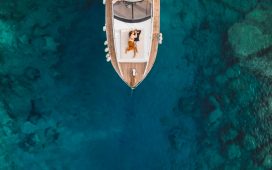We are lounging on the terrace of Lapis Turris, a medieval watchtower high in the Sibillini mountains, taking it in turns to name films that remind us of the extraordinary landscape that wraps itself around us. Game of Thrones? Skull Island in King Kong? Tolkien’s Rivendell? It’s difficult to pick; this stunning, empty wilderness is Italy’s answer to all three.
Parco Nazionale dei Monti Sibillini, in Le Marche’s mountainous southwest, is full of dense wooded hills, craggy peaks and lush green valleys. It is far wilder – and less populated – than neighbouring Tuscany and Umbria. You can go for days here before you spot anyone, let alone a tourist. It’s also a paradise for hikers and serious mountain bikers – with 10 peaks over 2,000m. Le Marche’s capital is Ancona – four hours from Rome by train.
Once you tire of the hills, the pretty beach towns on the Adriatic are perfect for a day trip – around a 90-minute drive to the coast. If all that isn’t seductive enough, there’s the cost – or relative lack of it. It’s one of the few places where you find yourself querying the bill for the novel fear you’ve been undercharged. An Aperol spritz in any of the local bars costs about €4 and pizzas are likely to be no more than €6.
Our closest town is Amandola, with ancient winding streets that lead on to Piazza Risorgimento, the old main square. Lined with bars and cafés, it’s the ideal stop for an aperitivo and is well stocked for food, with two supermarkets close by. We’re spoilt for choice with another picturesque local gem, the village of Montefortino. Perched on a neighbouring hill, it looks as if it’s been chiselled from marble. At sunset it gleams pink.
We visit on the second day and it doesn’t disappoint. A steep climb through the village leads us to a stunning panorama at the top with the Sibillini peaks laid out before us. It is eerily empty, though, as we are the only ones here to enjoy the view – except for the swallows. We retrace our steps to the foot of the village and stop at the Blu Bar Caffè, a pizzeria that is reassuringly lively and crowded. Locals queue for the delicious appetisers – stuzzichini – slices of pizza bianco, bruschetta and crostini. For about €5 each, we order plate after plate, washed down with beer, spritz and affogato to finish.
The real draw of this area are the contrasts and surprises. The mountain scenery may be spectacular, but there is also a sandy coastline to explore. We head for Sirolo, a pretty seaside town popular with Italian holidaymakers. It’s easy to see why it’s known as “the pearl of the Adriatic”, with its creamy pastel houses and turquoise shutters, and the piazza overlooking an azure sea.
The small town slopes gently towards the beach, which we reach through a strip of pine forest. It’s a steep descent and at the end of it is Spiagga di San Michele, a stunning sweep of fine white shingle and clear, crystalline water. We float on our backs in the sea looking up at the town framed by white cliffs and green hills beyond.
After a swim and a sunbathe, there’s one thing on our mind – no trip to the Italian coast is complete without a plate of spaghetti alle vongole. We stumble on a terrific place, Ristorante Vittoria – La Terrazza sul Mare – set back from the beach with a shaded terrace overlooking the ocean. It is one of those memorable meals that you hope for just once on any holiday, but can never guarantee. We strike lucky: sea-fresh frittura calamari, gamberi, antipasto di mare and vongole, augmented with salty chips, cheap prosecco and a stunning slice of the Adriatic. It’s as delightful a setting as anywhere you’d find on the Amalfi coast, but at a fraction of the price.
We amble slowly back up the hill to Sirolo, explore the maze of alleyways full of cafés and tempting boutiques, but stop only to look around Chiesa San Nicola di Bari, an 18th-century church with a stunning painted ceiling and ornate glass chandeliers. Outside, an ice-cream at Gelateria Artigianale is well worth the queue and, strolling back, our only regret is running out of time to stop at Il Grillo, a beautiful bar with tables overlooking the main street.
Back home at Lapis Turris, we settle down to another remote al fresco evening. It’s also pleasantly cool and mosquito-free, even when temperatures rise, thanks to its location 800m above sea level.
If you can bear to tear yourself away from the swimming pool and hot tub, quite an achievement in itself, there’s a small gate in the garden that leads to hiking trails. Easy-to-follow signs take you through rolling green hills and across a river with a gentle ascent of one peak – the view back towards the watchtower is well worth the climb.
Dating back to the 1080s, Lapis Turris is Le Marche’s oldest fortification, built to defend against the regular threat of an Umbrian attack. It must have been quite successful – one of the lower bedrooms is, reputedly, where prisoners were kept. Ten centuries later, it’s been lovingly converted by its owner into two apartments, which works well for two families sharing.
Medieval and solid, everything here is carved out of ancient rock: the tables and seats, the terraces and even a mini amphitheatre, which is floodlit at night – for special occasions, you can book a small orchestra to play. Or preferably just savour the nightly symphony of cicadas and the sound of water rushing through the woods below.
Lapis Turris sleeps up to nine people across two apartments, from £3,993 for seven nights – or £443pp – through Oliver’s Travels. For more details go to oliverstravels.com











